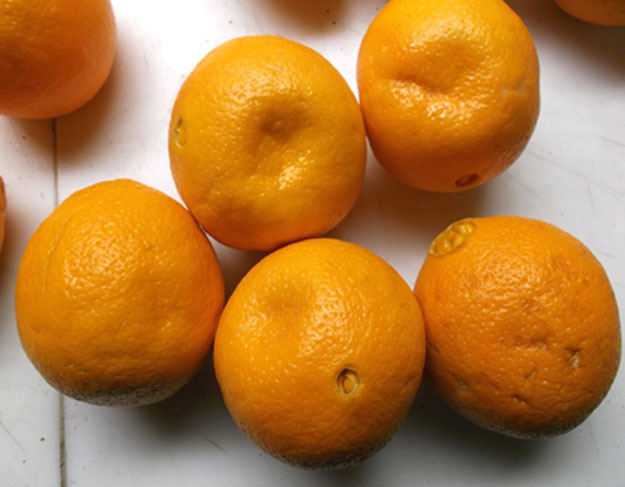We have all come across a defect we are not sure of what to call it. The USDA allows inspectors to describe the defect when this occurs. This picture of navel oranges was sent to me by an inspector, to help identify the defect.

Looking at the USDA Inspection Instructions for the three oranges, with the sunken areas, you may be confused with some other defects. Your first impression would be the oranges are bruised. But looking at the USDA’s definition of bruising: “Bruises generally occur because of movement in slack packs, pressure from a tight pack or weight from adjacent cartons. Bruises will have soft areas that, when cut, contain mushy areas in the underlying flesh. Affected fruit may be flattened on two or more sides. If the underlying flesh is not affected, these flattened areas may regain their shape. Do not score flattened areas unless the underlying flesh is mushy.”
If you have inspected citrus before you will notice these sunken areas are not characteristic of bruising. Bruising exhibits a flattening of the side(s) of the orange, and will only be scored as a defect if the underlying flesh is mushy. All citrus must be cut to determine if the underlying flesh is affected. These sunken areas do not resemble bruising, from adjacent oranges.
The USDA performed an inspection on these oranges and the inspector may have have been a bit confused. The inspector called these oranges two different defects, scoring half the defective oranges as bruising and the other half as badly puffy. I am not sure what criteria the inspector used to differentiate between the two. In all my years as a USDA inspector I never heard of any inspector finding the defect “badly puffy” when inspecting oranges. The USDA describes puffy as: “The U.S. Fancy and U.S. No. 1 grades require firm fruit. Fruit not meeting these requirements are scored against the total grade tolerance. If the fruit only shows signs of “puffy” skins, then score as damage (when the skin separates from more than half of the fruit) and report as ‘badly puffy.’ If all the skin has separated from the fruit, then score as serious damage and report as “extremely puffy.”
Looking at the above image you can clearly see the skin is not separating from the fruit, and it definitely is not separating from more than half of the fruit.
So if the above defect is not bruising and it is not puffy, what should you call it? As with all commodities inspected, if you are not sure what the defect is, it is best to simply describe it. I would call the defect, “Damage (or Serious Damage) by sunken, flattened areas, affecting from 10 to 25% of the surface.” Always cut a few of the defective oranges to determine if the underlying flesh was affected in any way.

3 Comments on “Oranges- Sunken Areas”
what is the size of the 72ct loose navel oranges plu 3107
Thanks for the question Latonya. Unfortunately the citrus industry does not state their size requirements they use. The USDA does not have any size requirements either. Maybe someone can help this question.
The defects in the Oranges and the classification of defects with the root cause are not clearly defined, rather I could not find them. This article brings out some clarity. Thanks.